In today’s fiercely competitive business landscape, customer loyalty has become a coveted asset for organizations across industries. Retaining customers and fostering long-lasting relationships is not only crucial for revenue growth but also for building a strong brand reputation.
As consumer expectations continue to evolve, businesses that fail to prioritize exceptional customer service risk losing their valuable customer base to competitors who understand the importance of delivering outstanding experiences.
At the heart of customer loyalty lies the quality of service provided by an organization. Customers are more likely to remain loyal to brands that consistently meet or exceed their expectations, treating them with respect, empathy, and a genuine commitment to solving their problems.
In essence, customer service policies play a pivotal role in shaping the overall customer experience and ultimately driving loyalty.
Implementing customer-centric service policies is not just about providing good support; it’s a strategic approach that permeates every aspect of an organization’s operations.
Effective customer service policies can transform a business’s relationship with customers by empowering employees to make decisions that benefit the customer and streamlining processes for seamless interactions.
Industry leaders across various sectors have demonstrated the power of customer service retentioan in cultivating loyalty and achieving long-term success. By examining their strategies and lessons learned, businesses can gain valuable insights into how to craft and implement policies that resonate with their customers, fostering trust, satisfaction, and lasting relationships.
This article explores the key components of effective customer service policies, showcases real-world examples from industry leaders, and provides best practices for organizations seeking to leverage the power of customer service to drive loyalty.
By prioritizing customer-centric policies, businesses can not only retain their existing customer base but also attract new customers through positive word-of-mouth and a reputation for exceptional service.
What are Customer Service Policies?
Customer service policies are the foundation of a positive customer experience. They are essentially a rulebook that outlines how a company interacts with its customers, ensuring consistent, high-quality service. These policies benefit both businesses and their customers.
For Businesses:
Customer service policies provide clear guidelines for employees on how to handle inquiries, complaints, and various customer situations. This promotes efficiency and ensures everyone is on the same page.
For Customers:
Customer service policies, when made public, inform customers about what level of service to expect. This builds trust and sets clear expectations for how their concerns will be addressed.
Overall, customer service policies are a roadmap to creating a positive and consistent customer experience.
The Power of Customer Service Policies
Customer service policies are more than just written documents; they’re the foundation upon which successful customer interactions are built. These policies serve as a roadmap, guiding employee behavior and ensuring every customer’s consistent, positive experience.
Setting the Stage for Positive Interactions
Imagine a customer walks into a store with a problem. Clear customer service policies ensure all employees approach the situation similarly. This doesn’t mean robotic interactions; instead, it creates a framework for effective communication.
Policies might outline preferred communication channels (phone, email, live chat) and emphasize active listening techniques to fully understand the customer’s concern. Problem-solving procedures can be detailed, outlining a step-by-step approach to resolving issues and establishing escalation protocols for complex situations.
Empowerment is another key element. Customer service policies can define the level of decision-making authority granted to employees, allowing them to address customer concerns effectively without unnecessary delays.
The Impact on Employees and Customers
The benefits of well-defined customer service policies extend to both employees and customers. Empowered employees are equipped with the knowledge and confidence to handle customer interactions effectively. This fosters a sense of ownership and can lead to increased job satisfaction and a more positive work environment.
Customers reap the rewards of consistency. They can expect the same level of service regardless of the employees they interact with. Clear policies streamline the problem-solving process, leading to faster resolutions and reduced frustration.
Additionally, well-designed policies ensure employees handle situations calmly and professionally, even under pressure, fostering a sense of trust and respect.
The Downside of Poor Policy Implementation
While customer service policies are essential, there can be downsides to poorly implemented ones. Rigid or overly complex policies can restrict employee actions and hinder their ability to solve problems creatively.
Imagine a situation where a customer service rep is unable to offer a simple solution because company policy dictates a lengthy approval process. This can lead to frustration for both the customer and the employee.
Another pitfall is prioritizing metrics over customer satisfaction. Policies that emphasize numbers over genuine care can result in impersonal interactions.
Customers may feel like they’re just another statistic, not a valued patron. Finally, a lack of clear communication regarding policies can be detrimental. If employees aren’t properly trained on the guidelines, it can lead to confusion and inconsistent customer experiences.
Key Components of Effective Customer Service Policies

Putting customers first: Understanding customer needs and expectations
Effective customer service policies must be grounded in a deep understanding of customer needs and expectations. Organizations should conduct regular research, gather feedback, and analyze customer data to gain insights into their target audience’s preferences, pain points, and desired experiences. This knowledge should then be incorporated into policies that prioritize meeting and exceeding customer expectations at every touchpoint.
How ThriveDesk put its customers first
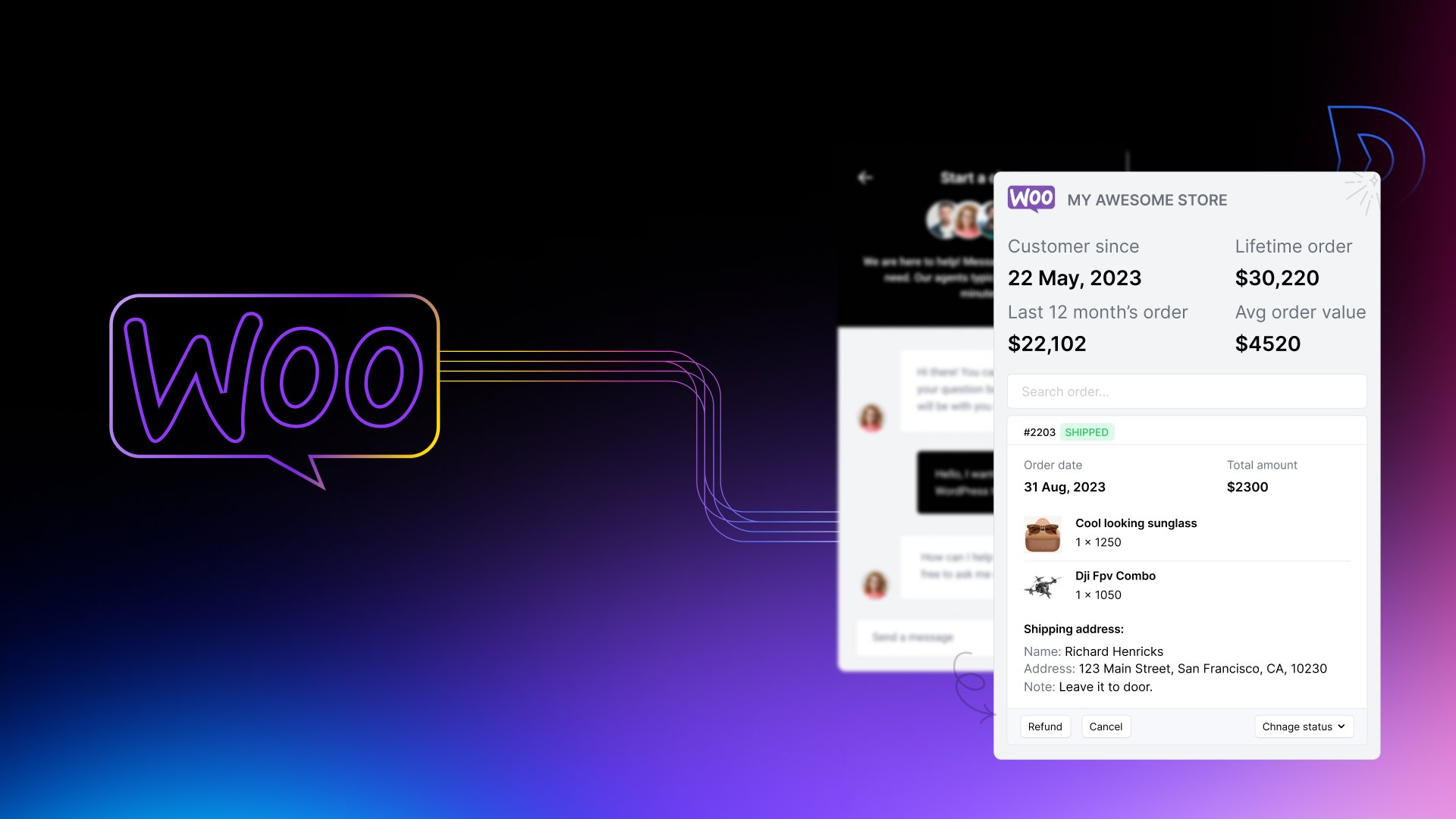
We at ThriveDesk firmly believe in a customer first approach to providing service because at the end of the day all that we do is for our customers. One way we’ve done this and continue to do this is by actively listening to our customer base and adjusting our offerings to meet their evolving needs. Despite having a predetermined roadmap, We at ThriveDesk take pride in our ability to demonstrate agility and responsiveness.
One recent example is the rapid development and launch of our WooCommerce integration to meet the growing demand for seamless support within this popular e-commerce platform. This proactive approach ensured customers could provide exceptional support experiences directly within the WooCommerce environment.
Empowering employees to deliver exceptional service
Front-line employees are a company’s face and play a pivotal role in shaping customer experiences. Empowering them with the right tools, training, and decision-making authority is essential for delivering exceptional service. Policies that encourage employees to take ownership, exercise discretion, and go above and beyond to resolve customer issues can lead to higher levels of satisfaction and loyalty.
How ThriveDesk empowers it employees
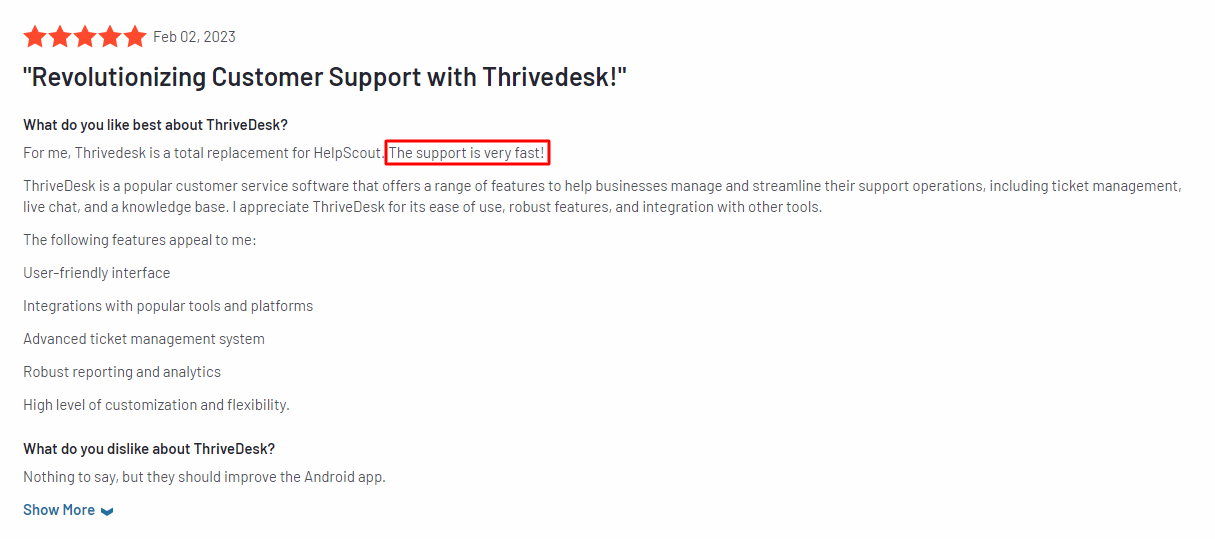
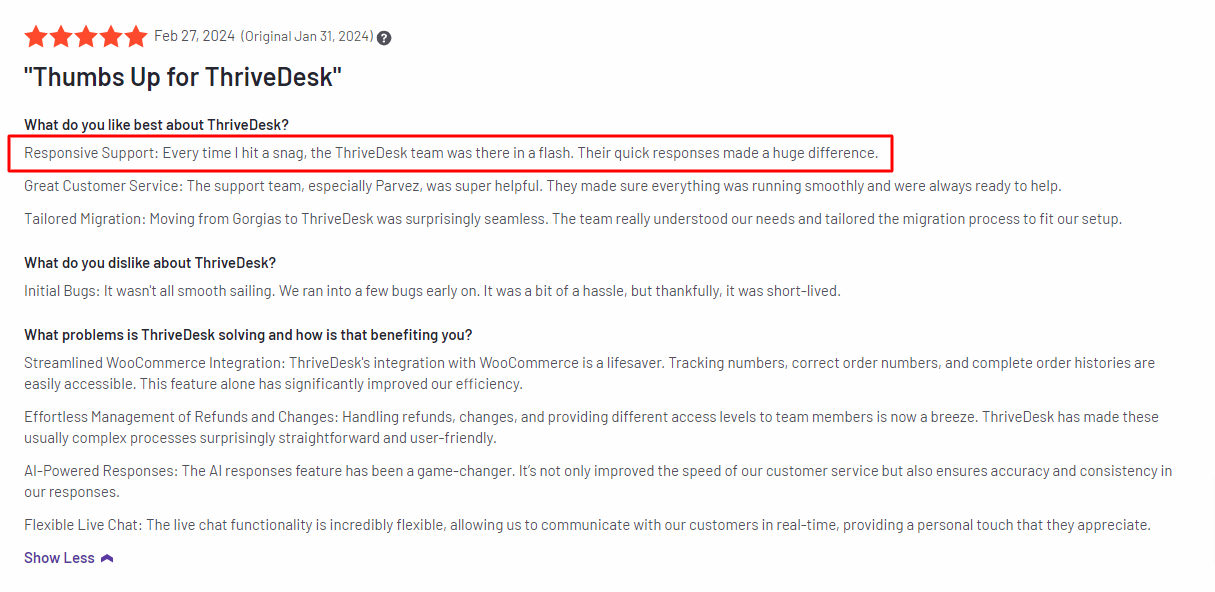
Here at ThriveDesk, we take our customer service duties very seriously. We regularly communicate with our customer service team to ensure that certain standards are never allowed to drop. We do regular service evaluations and provide sufficient training when deficiencies are found. If an agent lacks a certain skill, we fully provide and actualize resources till they obtain the skill in question. It is for this reason that our customer service is considered one of the most responsive and skillful in our niche.
Streamlining processes for seamless customer experiences
Customer service policies should aim to simplify and optimize processes to ensure a seamless experience for customers. This may involve eliminating unnecessary steps, integrating various channels (e.g., in-person, online, mobile), and providing clear guidelines for efficient issue resolution. Streamlined processes not only enhance the customer experience but also improve operational efficiency and employee productivity.
How ThriveDesk streamlines processes for seamless customer experiences

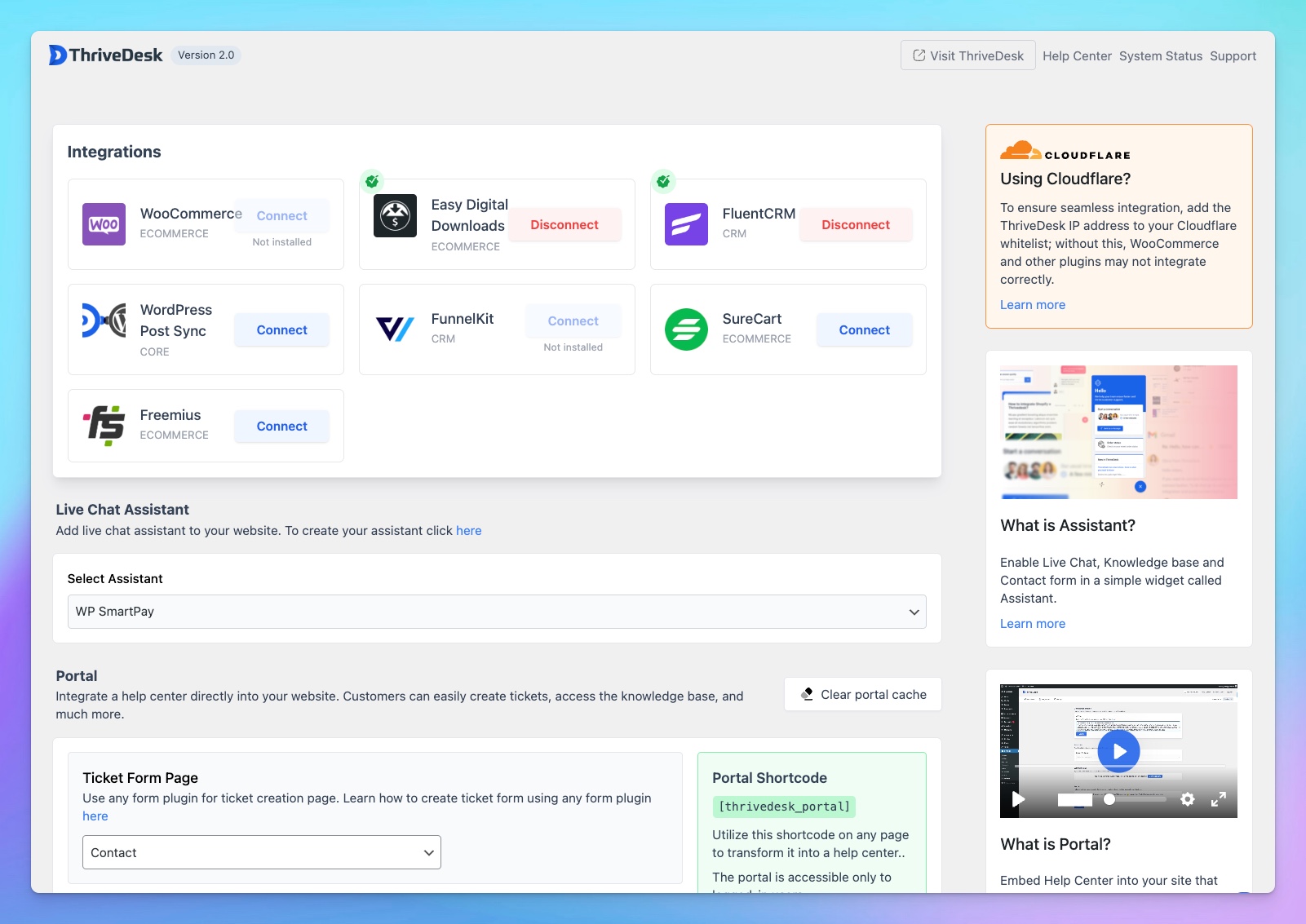
ThriveDesk demonstrates this principle through its efforts to streamline the onboarding experience for WordPress plugin users. Recognizing the challenges faced by this customer segment, we prioritized enhancing the onboarding process, eliminating unnecessary steps and providing a smoother introduction to their platform. This streamlined approach improved the customer experience and increased operational efficiency, as customers could quickly familiarize themselves with the platform and utilize its features effectively.
Streamlining processes is essential for delivering seamless customer experiences and fostering loyalty. By continuously identifying and addressing pain points, simplifying procedures, and integrating various channels, organizations can ensure that customers receive consistent, efficient, and hassle-free support, regardless of the touchpoint they engage with.
Leveraging technology to enhance customer interactions
In today’s digital age, technology plays a vital role in shaping customer interactions. Customer service policies should incorporate the use of appropriate technologies, such as chatbots, live chat, self-service portals, and customer relationship management (CRM) systems, to enhance communication, personalize experiences, and provide real-time support.
However, it’s essential to strike a balance between technology and human interaction, ensuring that customers can still access personal assistance when needed.
How ThriveDesk leverages technology to enhance customer interactions
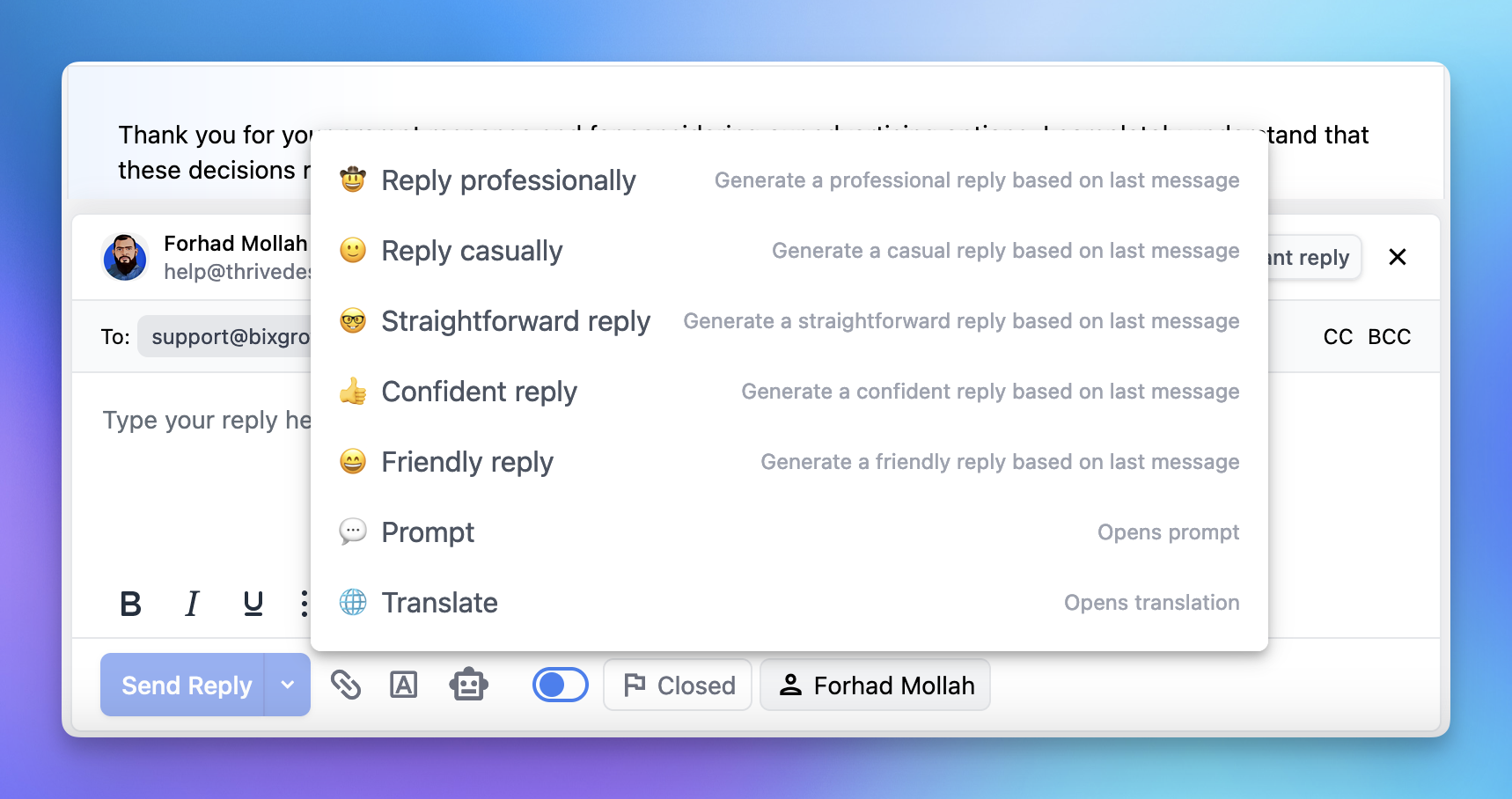
ThriveDesk exemplifies the effective leveraging of technology to enhance customer interactions through its innovative AI reply editor. This cutting-edge feature harnesses the power of advanced natural language processing capabilities, enabling more efficient and accurate response generation. By integrating AI functionality into their platform, ThriveDesk empowers its users to provide faster and more personalized support, improving the overall customer experience.
The AI reply editor allows customer service representatives to quickly draft high-quality responses by leveraging AI-generated suggestions based on the customer’s query. This not only saves time but also ensures that responses are tailored to the specific context, addressing the customer’s needs more effectively. Additionally, the AI-powered suggestions can help maintain a consistent tone and language across all customer interactions, further enhancing the overall experience.
While the AI reply editor streamlines the response process, ThriveDesk recognizes the importance of human interaction in customer service. As such, the platform strikes a balance by allowing representatives to review and modify the AI-generated responses as needed, ensuring a personalized touch applogy and the ability to address more complex or nuanced issues that may require human expertise.
By leveraging cutting-edge technology like the AI reply editor, ThriveDesk demonstrates its commitment to enhancing customer interactions through innovative solutions. This approach not only improves operational efficiency but also delivers a more seamless and personalized experience for customers, fostering loyalty and satisfaction.
Continuous improvement through feedback and analytics
Effective customer service policies are not static; they should evolve and adapt to changing customer needs and market dynamics. Organizations should establish mechanisms for gathering and analyzing customer feedback, as well as monitoring key performance indicators (KPIs) and metrics. This data can then be used to identify areas for improvement, refine existing policies, and implement new strategies to enhance the overall customer experience.
By incorporating these key components into their customer service policies, organizations can foster a customer-centric culture, deliver exceptional experiences, and ultimately drive customer loyalty and long-term success.
In the last 6 months, ThriveDesk has rolled out over 5 major features and continuously fixed bugs every single day, all driven by customer feedback and data analytics.
Implementing Customer Service Policies: Best Practices

Crafting effective customer service policies is just the first step; successful implementation is equally crucial for driving customer loyalty.
Organizations must adopt a strategic and holistic approach to ensure that these policies are seamlessly integrated into their operations and consistently executed across all customer touchpoints.
By following best practices, businesses can maximize the impact of their customer service policies and create a culture of exceptional customer experiences. Let’s look at some of these best practices.
Aligning policies with company values and goals
Effective customer service policies should be deeply rooted in the company’s core values and long-term goals. Organizations must ensure that their policies are consistent with their mission, vision, and overall business strategy. This alignment not only fosters a cohesive and authentic brand experience but also ensures that real-time customer service efforts directly contribute to the achievement of broader organizational objectives.
Involving employees in policy development
Customer-facing employees are at the forefront of customer interactions and possess invaluable insights into customer needs and pain points. Involving them in the development and refinement of customer service policies can lead to more practical and effective solutions. By actively seeking employee feedback and incorporating their perspectives, organizations can create policies that are grounded in real-world experiences and better equipped to address customer challenges.
Continuous training and reinforcement
Implementing customer service policies is not a one-time event; it requires continuous training and reinforcement to ensure consistent implementation across the organization. Regular training sessions should be conducted to keep employees up-to-date with policy changes, best practices, and evolving customer expectations. Additionally, ongoing coaching and feedback mechanisms can help reinforce desired behaviors and address any gaps or areas for improvement.
Measuring and tracking customer satisfaction metrics
To effectively evaluate the impact and success of customer service policies, organizations must establish clear metrics for measuring customer satisfaction. This may include tracking metrics such as customer satisfaction scores, net promoter scores, response times, and resolution rates. By regularly monitoring and analyzing these metrics, businesses can identify areas where policies may need adjustment or refinement, and make data-driven decisions to continuously improve the customer experience.
Adapting policies to changing customer expectations
Customer expectations are not static; they evolve over time influenced by factors such as technological advancements, market trends, and changing consumer behaviors. To remain relevant and competitive, businesses must be proactive in adapting their customer service policies to keep pace with these shifting expectations. Regular market research, customer feedback gathering, and industry benchmarking can help organizations identify emerging trends and make informed decisions about policy updates or revisions.
By following these best practices, organizations can effectively implement customer service policies that not only meet but exceed customer expectations, fostering loyalty, building lasting relationships, and driving long-term business success.
The Path to Lasting Loyalty
In today’s fiercely competitive landscape, customer loyalty is the ultimate prize. Organizations can forge enduring bonds with their customers by crafting and effectively implementing customer service policies that prioritize exceptional experiences, fostering trust, satisfaction, and unwavering allegiance.
ThriveDesk exemplifies this approach, leveraging innovative technologies like AI reply editors and empowering employees to deliver seamless, personalized interactions that deeply resonate with customers.
The key lies in a holistic strategy that aligns policies with organizational values, involves employees in their development, and continuously adapts to evolving customer expectations. Embracing best practices such as continuous training, measuring customer satisfaction metrics, and proactively responding to market trends ensures policies remain effective in driving loyalty.
Investing in customer service policies is an investment in long-term success. Loyal customers contribute to sustained revenue and serve as brand ambassadors through positive word-of-mouth. In an era of rising expectations, businesses prioritizing customer service policies gain a competitive edge and cement their industry leadership.





